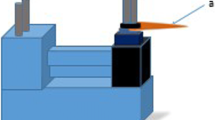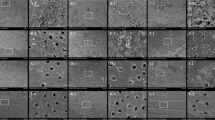Abstract
Introduction
Dental caries and apical periodontitis are ones of the most prevalent chronic diseases and involve infection by cariogenic and endodontic bacteria. It can be said that the most required to cure is disinfection. We hypothesized that NB-UVB could be used for intraoral disinfection without affecting cells, and that it could be used in combination with TiO2 to disinfect complex root canals. The objectives were to investigate the effects of UV on dental pulp cells and oral bacteria and to evaluate the enhancement effect of a photocatalyst on bactericidal effects of UV irradiation.
Methods
UV irradiation devices of UVB (310, 285 nm) and UVC (265 nm) were prepared. Cell proliferation and cytotoxicity assays after UV irradiation were performed using human dental pulp cells. The antibacterial activity of UV irradiation was investigated in Streptococcus mutans, Staphylococcus aureus, Enterococcus faecalis, Actinomyces naeslundii, Porphyromonas gingivalis, and Fusobacterium nucleatum. A curved simulated root canal with plastic training block was used to evaluate the effect of combined UV and TiO2 treatment. Data were analyzed by one-way ANOVA (p < 0.05) followed by Tukey’s post hoc tests (p < 0.05).
Results
Human dental pulp cell proliferation was decreased by 265 nm, 285 nm, and 310 nm UV irradiation, although 310 nm UV irradiation did not show cytotoxic effects on these cells. Oral bacterial growth was suppressed following UV irradiation at 285 nm and 265 nm. Viability of all bacteria significantly decreased with UV irradiation. In the curved simulated root canal, viability of E. faecalis in UV irradiation at 285 nm with long taper fibers was significantly decreased in the 300 s irradiation group. E. faecalis proliferation was inhibited by combined UV irradiation and TiO2 application with long taper fibers in the curved simulated root canal.
Conclusions
The wavelength of UVB and UVC showed bactericidal effects on oral bacteria including caries-related bacteria and apical periodontitis–related bacteria while NB-UVB did not. UVB with longer fibers was more effective in disinfection on E. faecalis in curved simulated root canal, and the combined use of photocatalyst further improved the disinfection effect.




Similar content being viewed by others
References
Petean IBF, Kuchler EC, Soares IMV, Segato RAB, Silva L, Antunes LAA, Salles AG, Antunes LS, Sousa-Neto MD (2019) Genetic polymorphisms in RANK and RANKL are associated with persistent apical periodontitis. J Endod 45(5):526–531. https://doi.org/10.1016/j.joen.2018.10.022
Schafer E, Diez C, Hoppe W, Tepel J (2002) Roentgenographic investigation of frequency and degree of canal curvatures in human permanent teeth. J Endod 28(3):211–216. https://doi.org/10.1097/00004770-200203000-00017
Pineda F, Kuttler Y (1972) Mesiodistal and buccolingual roentgenographic investigation of 7,275 root canals. Oral Surgery, Oral Medicine, Oral Pathology, and Oral Radiology 33(1):101–110. https://doi.org/10.1016/0030-4220(72)90214-9
Batista LF, Kaina B, Meneghini R, Menck CF (2009) How DNA lesions are turned into powerful killing structures: insights from UV-induced apoptosis. Mutat Res 681(2-3):197–208. https://doi.org/10.1016/j.mrrev.2008.09.001
Treister N, Li S, Lerman MA, Lee S, Soiffer R (2015) Narrow-band UVB phototherapy for management of oral chronic graft-versus-host disease. Photodermatol Photoimmunol Photomed 31(2):75–82. https://doi.org/10.1111/phpp.12141
Svobodova A, Walterova D, Vostalova J (2006) Ultraviolet light induced alteration to the skin. Biomed Pap Med Fac Univ Palacky Olomouc Czech Repub 150(1):25–38
Jordan T (2015) UVC irradiation. Is it the future of infection prevention in the clinical laboratory? Medical Laboratory Observer 47 (6):41
Lapolla W, Yentzer BA, Bagel J, Halvorson CR, Feldman SR (2011) A review of phototherapy protocols for psoriasis treatment. J Am Acad Dermatol 64(5):936–949. https://doi.org/10.1016/j.jaad.2009.12.054
Patrizi A, Raone B, Ravaioli GM (2015) Management of atopic dermatitis: safety and efficacy of phototherapy. Clin Cosmet Investig Dermatol 8:511–520. https://doi.org/10.2147/CCID.S87987
Batista LF, Roos WP, Kaina B, Menck CF (2009) p53 mutant human glioma cells are sensitive to UV-C-induced apoptosis due to impaired cyclobutane pyrimidine dimer removal. Mol Cancer Res 7(2):237–246. https://doi.org/10.1158/1541-7786.MCR-08-0428
Uchinuma S, Shimada Y, Matin K, Hosaka K, Yoshiyama M, Sumi Y, Tagami J (2019) Effects of UVB and UVC irradiation on cariogenic bacteria in vitro. Lasers Med Sci 34(5):981–989. https://doi.org/10.1007/s10103-018-2685-4
Fujiyama A, Honda K (1972) Electrochemical photocatalysis of water at semiconductor electrode. Nature 238:27–38
Wei C, Lin WY, Zainal Z, Williams NE, Zhu K, Kruzic AP, Smith RL, Rajeshwar K (1994) Bactericidal activity of TiO2 photocatalyst in aqueous media: toward a solar-assisted water disinfection system. Environ Sci Technol 28(5):934–938. https://doi.org/10.1021/es00054a027
Pham HN, McDowell T, Wilkins E (1995) Photocatalytically-mediated disinfection of water using tio2as a catalyst and spore-forming Bacillus pumilusas a model. Journal of Environmental Science and Health Part A: Environmental Science and Engineering and Toxicology 30(3):627–636. https://doi.org/10.1080/10934529509376221
Kim B, Kim D, Cho D, Cho S (2003) Bactericidal effect of TiO2 photocatalyst on selected food-borne pathogenic bacteria. Chemosphere 52(1):277–281. https://doi.org/10.1016/S0045-6535(03)00051-1
Mandell RL, Socransky SS (1981) A selective medium for Actinobacillus actinomycetemcomitans and the incidence of the organism in juvenile periodontitis. J Periodontol 52(10):593–598. https://doi.org/10.1902/jop.1981.52.10.593
Takada A, Matsushita K, Horioka S, Furuichi Y, Sumi Y (2017) Bactericidal effects of 310 nm ultraviolet light-emitting diode irradiation on oral bacteria. BMC Oral Health 17(1):96. https://doi.org/10.1186/s12903-017-0382-5
Alves FRF, Paiva PL, Marceliano-Alves MF, Cabreira LJ, Lima KC, Siqueira JF Jr, Rocas IN, Provenzano JC (2018) Bacteria and hard tissue debris extrusion and intracanal bacterial reduction promoted by XP-endo Shaper and Reciproc instruments. J Endod 44(7):1173–1178. https://doi.org/10.1016/j.joen.2018.04.007
Rastogi RP, Richa KA, Tyagi MB, Sinha RP (2010) Molecular mechanisms of ultraviolet radiation-induced DNA damage and repair. Journal of Nucleic Acids 2010:592980. https://doi.org/10.4061/2010/592980
Polefka TG, Meyer TA, Agin PP, Bianchini RJ (2012) Effects of solar radiation on the skin. J Cosmet Dermatol 11(2):134–143. https://doi.org/10.1111/j.1473-2165.2012.00614.x
Stuart CH, Schwartz SA, Beeson TJ, Owatz CB (2006) Enterococcus faecalis: its role in root canal treatment failure and current concepts in retreatment. J Endod 32(2):93–98. https://doi.org/10.1016/j.joen.2005.10.049
Wainwright M (1998) Photodynamic antimicrobial chemotherapy (PACT). J Antimicrob Chemother 42(1):13–28. https://doi.org/10.1093/jac/42.1.13
Maisch T, Hackbarth S, Regensburger J, Felgentrager A, Baumler W, Landthaler M, Roder B (2011) Photodynamic inactivation of multi-resistant bacteria (PIB) - a new approach to treat superficial infections in the 21st century. Journal der Deutschen Dermatologischen Gesellschaft 9(5):360–366. https://doi.org/10.1111/j.1610-0387.2010.07577.x
Morimoto K, Ozawa T, Awazu K, Ito N, Honda N, Matsumoto S, Tsuruta D (2014) Photodynamic therapy using systemic administration of 5-aminolevulinic acid and a 410-nm wavelength light-emitting diode for methicillin-resistant Staphylococcus aureus-infected ulcers in mice. PLoS One 9(8):e105173. https://doi.org/10.1371/journal.pone.0105173
Kumar V, Sinha J, Verma N, Nayan K, Saimbi CS, Tripathi AK (2015) Scope of photodynamic therapy in periodontics. Indian J Dent Res 26(4):439–442. https://doi.org/10.4103/0970-9290.167636
Shephard GS, Stockenstrom S, De Villiers D, Engelbrecht WJ, Sydenham EW, Wessels GF (1998) Photocatalytic degradation of cyanobacterial microcystin toxins in water. Toxicon 36(12):1895–1901
Acknowledgements
The authors thank Christina Croney, PhD, from Edanz Group (www.edanzediting.com/ac), for editing a draft of this manuscript.
Funding
This study was financially supported by JSPS KAKENHI Grant Number JP17K17355 from the Japan Society for the Promotion of Science and by the Research Grant for Longevity Science (29-3) from the Japanese Ministry of Health, Labor and Welfare.
Author information
Authors and Affiliations
Corresponding author
Ethics declarations
Ethical approval
All procedures were approved by the Kyushu University Institutional Review Board for Human Genome/Gene Research (approval number: 20A-E).
Conflict of interest
The authors declare no competing interests.
Additional information
Publisher’s note
Springer Nature remains neutral with regard to jurisdictional claims in published maps and institutional affiliations.
Supplementary information
Rights and permissions
About this article
Cite this article
Haraguchi, A., Yoshida, S., Takeshita, M. et al. Effects of ultraviolet irradiation equipment on endodontic disease–related bacteria. Laser Dent Sci 6, 31–40 (2022). https://doi.org/10.1007/s41547-021-00145-8
Received:
Accepted:
Published:
Issue Date:
DOI: https://doi.org/10.1007/s41547-021-00145-8





